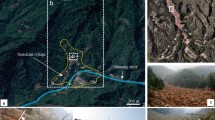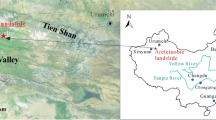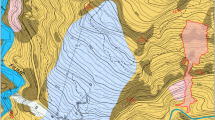Abstract
The 2008 Ms 8.0 Wenchuan earthquake triggered a large number of extensive landslides. It also affected geologic properties of the mountains such that large-scale landslides followed the earthquake, resulting in the formation of a disaster chain. On 10 July 2013, a catastrophic landslide–debris flow suddenly occurred in the Dujiangyan area of Sichuan Province in southeast China. This caused the deaths of 166 people and the burying or damage of 11 buildings along the runout path. The landslide involved the failure of ≈1.47 million m3, and the displaced material from the source area was ≈0.3 million m3. This landslide displayed shear failure at a high level under the effects of a rainstorm, which impacted and scraped an accumulated layer underneath and a heavily weathered rock layer during the release of potential and kinetic energies. The landslide body entrained a large volume of surface residual diluvial soil, and then moved downstream along a gully to produce a debris flow disaster. This was determined to be a typical landslide–debris flow disaster type. The runout of displaced material had a horizontal extent of 1200 m and a vertical extent of 400 m. This was equivalent to the angle of reach (fahrböschung angle) of 19° and covered an area of 0.2 km2. The background and motion of the landslide are described in this study. On the basis of the above analysis, dynamic simulation software (DAN3D) and rheological models were used to simulate the runout behavior of the displaced landslide materials in order to provide information for the hazard zonation of similar types of potential landslide–debris flows in southeast China following the Wenchuan earthquake. The simulation results of the Sanxicun landslide revealed that the frictional model had the best performance for the source area, while the Voellmy model was most suitable for the scraping and accumulation areas. The simulations estimated that the motion could last for ≈70 s, with a maximum speed of 47.7 m/s.

















Similar content being viewed by others
References
Boultbee N (2005) Characterization of the Zymoetz River rock avalanche. M.Sc. thesis, Simon Fraser University, Burnaby
Corominas J (1996) The angle of reach as a mobility index for small and large landslides. Can Geotech J 33(2):260–271
Cui P, Zhu YY, Han YS, Chen XQ, Zhuang JQ (2009) The 12 May Wenchuan earthquake induced landslide lakes: distribution and preliminary risk evaluation. Landslides 6(3):209–223
Evans SG, Hungr O, Clague JJ (2001) Dynamics of the 1984 rock avalanche and associated distal debris flow on mount Cayley, British Columbia, Canada; implications for landslide hazard assessment on dissected volcanoes. Eng Geol 61:29–51
GEO (2011) Guidelines on the assessment of debris mobility for channelised debris flows. GEO Technical Guidance Note No. 29. Geotechnical Engineering Office, Civil Engineering and Development Department, The Government of the Hong Kong Special Administrative Region, 6p
GEO (2012) Guidelines on assessment of debris mobility for open hillslope failures. GEO Technical Guidance Note No. 34. Geotechnical Engineering Office, Civil Engineering and Development Department, The Government of the Hong Kong Special Administrative Region, 16p
GEO (2013) Guidelines on the assessment of debris mobility for failures within topographic depression catchments. GEO Technical Guidance Note No. 38. Geotechnical Engineering Office, Civil Engineering and Development Department, The Government of the Hong Kong Special Administrative Region, 8p
Huang RQ, Xu Q, Huo JJ (2011) Mechanism and geo-mechanics models of landslides triggered by 5.12 Wenchuan earthquake. J Mt Sci 8(2):200–210
Huang RQ, Pei XJ, Fan XM, Zhang WF (2012a) The characteristics and failure mechanism of the largest landslide triggered by the Wenchuan earthquake, May 12, 2008, China. Landslides 9:131–142
Hungr O, Evans S (1996) Rock avalanche runout prediction using a dynamic model. In: Proceedings of the 7th International Symposium on Landslides, vol 1. Trondheim, Norway, pp 233–238
Hungr O, Evans SG (2004) Entrainment of debris in rock avalanches: an analysis of a long run-out mechanism[J]. Geol Soc Am Bull 116(9–10):1240–1252
Hungr O, McDougall S (2009) Two numerical models for landslide dynamic analysis[J]. Comput Geosci 35(5):978–992
Hungr O, Dawson RF, Kent A et al (2002) Rapid flow slides of coal-mine waste in British Columbia, Canada [J]. Rev Eng Geol 15:191–208
Hungr O, Corominas J, Eberhardt E (2005) Estimating landslide motion mechanism, travel distance and velocity. Landslide Risk Management:99–128
Kwan JSH, Sun HW (2006) An improved landslide mobility model. Can Geotech J 43(5):31–539
McDougall S (2006) A new continuum dynamic model for the analysis of extremely rapid landslide motion across complex 3D terrain[D]. Doctoral dissertation, University of British Columbia, pp 169–225
McDougall S, Hungr O (2004) A model for the analysis of rapid landslide motion across three-dimensional terrain. Can Geotech J 41(6):1084–1097
Parker RN, Densmore AL, Rosser NJ, de Michele M, Li Y, Huang RQ, Whadcoat S, Petley DN (2011) Mass wasting triggered by the 2008 Wenchuan earthquake is greater thanorogenic growth. Nat Geosci 4(7):449–452
Scheidegger A E (1973) On the prediction of the reach and velocity of catastrophic landslides. Rock Mech Rock Eng 5(4):231–236
Sosio R, Crosta GB, Hungr O (2008) Complete dynamic modeling calibration for the Thurwieser rock avalanche (Italian Central Alps). Eng Geol 100(1):11–26
Tang C, Zhu J, Li WL (2009) Rainfall-triggered debris flows following the Wenchuan earthquake. Bull Eng Geol Environ 68:187–194
Tang C, Van Asch TWJ, Chang M, Chen GQ, Zhao XH, Huang XC (2012) Catastrophicdebris flows on 13 August 2010 in the Qingping area, southwestern China: thecombined effects of a strong earthquake and subsequent rainstorms. Geomorphology 139–140:559–576
Wong HN, Ko FWY, Hui THH (2006) Assessment of landslide risk of Natural hillsides in Hong Kong (GEO report no. 191). Geotechnical Engineering Office, Hong Kong, 117 P
Xing AG, Wang GH, Li B et al (2014) Long-runout mechanism and landsliding behaviour of large catastrophic landslide triggered by heavy rainfall in Guanling, Guizhou, China[J]. Can Geotech J 52(7):971–981
Xing A, Wang G, Yin Y, et al (2015) Investigation and dynamic analysis of a catastrophic rock avalanche on September 23, 1991, Zhaotong, China[J]. Landslides 13(5):1035–1047
Xing A, Yuan X, Xu Q et al (2016) Characteristics and numerical runout modelling of a catastrophic rock avalanche triggered by the Wenchuan earthquake in the Wenjia valley, Mianzhu, Sichuan, China. Landslides doi:10.1007/s10346-016-0707-5
Yin YP (2014) Vertical acceleration effect on landsides triggered by the Wenchuan earthquake, China. Environ Earth Sci 71:4703–4714
Yin YP, Wang FW, Sun P (2009) Landslide hazards triggered by the 2008 Wenchuan earthquake, Sichuan, China. Landslides 6(2):139–152
Yin YP, Zheng WM, Li XC et al (2011) Catastrophic landslides associated with the M8.0 Wenchuan earthquake. Bull Eng Geol Environ 70(1):15–32
Yin Y, Cheng Y, Liang J, Wang W (2016) Heavy-rainfall-induced catastrophic rockslidedebris flow at Sanxicun, Dujiangyan, after the Wenchuan Ms 8.0 earthquake. Landslides 13(1):9–23
Zhang M, Yin YP, Wu SR (2010) Development status and prospects of studies on kinematics of long runout rock avalanches[J]. J Eng Geol 18(6):805–817
Zhang S, Zhang LM, Chen HX (2014a) Relationships among three repeated large-scaledebris flows at the Pubugou ravine in the Wenchuan earthquake zone. Can Geotech J51(9):51–965
Acknowledgments
This study was supported by the National Natural Science Foundation of China (nos. 41472295 and 41302246). The authors express their gratitude to Prof. Xing Aiguo and Drs. Wang Lei and He Kai for the kind support and guidance. We are grateful to Prof. O. Hungr for supplying a copy of the DAN3D software.
Author information
Authors and Affiliations
Corresponding author
Rights and permissions
About this article
Cite this article
Gao, Y., Yin, Y., Li, B. et al. Characteristics and numerical runout modeling of the heavy rainfall-induced catastrophic landslide–debris flow at Sanxicun, Dujiangyan, China, following the Wenchuan Ms 8.0 earthquake. Landslides 14, 1361–1374 (2017). https://doi.org/10.1007/s10346-016-0793-4
Received:
Accepted:
Published:
Issue Date:
DOI: https://doi.org/10.1007/s10346-016-0793-4




